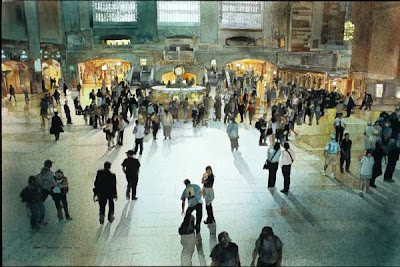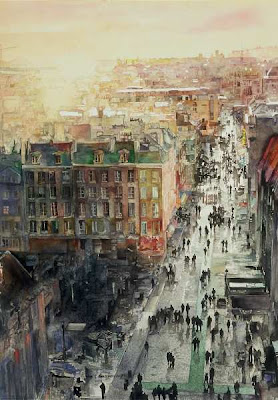 John Salminen (continued): In the early 80s, I had an opportunity to study with Cheng-Khee Chee at the University of Minnesota and Chee, at that time, was being introduced to western design and he was sharing all of that with us in the class. That was actually my first experience with a practical application for design, how you can use design to actually improve the painting that you were working on.
John Salminen (continued): In the early 80s, I had an opportunity to study with Cheng-Khee Chee at the University of Minnesota and Chee, at that time, was being introduced to western design and he was sharing all of that with us in the class. That was actually my first experience with a practical application for design, how you can use design to actually improve the painting that you were working on.Creative Catalyst: And this was a major breakthrough ?
John: I think it was. As I look at it now, it’s been such a dominant influence on my thinking and my work. I don’t know if I recognized it as a break through at the time, but everyone in the class, and I’m sure this is fairly typical, we all wanted to paint just like Chee. I realized early on that that was not a productive route to follow, to be the second Cheng-Khee Chee. I had been looking around for other painters and discovered Robert Wood and the whole California school of fast and loose painters.
 In that genre, I fixated for a while on a California painter named Morris Shulman and in particular his paintings called “Bus Stop” and “The Arches.” For the next couple years I literally copied Morris Shulman. I had Chee, Robert Wood and Morris Shulman and I was internalizing what they were doing by attempting to copy them. All of a sudden one day someone came up to me and they said, ''We saw one of your paintings. We always recognize your work by its style.'' I hadn’t really thought at all about having a style at that point in time, and in reality, there was the combined influence of de Koonig and Franz Kline and Cheng-Khee Chee and Robert Wood and the California painters and everything else I’d seen along the way that probably had an affect.
In that genre, I fixated for a while on a California painter named Morris Shulman and in particular his paintings called “Bus Stop” and “The Arches.” For the next couple years I literally copied Morris Shulman. I had Chee, Robert Wood and Morris Shulman and I was internalizing what they were doing by attempting to copy them. All of a sudden one day someone came up to me and they said, ''We saw one of your paintings. We always recognize your work by its style.'' I hadn’t really thought at all about having a style at that point in time, and in reality, there was the combined influence of de Koonig and Franz Kline and Cheng-Khee Chee and Robert Wood and the California painters and everything else I’d seen along the way that probably had an affect.Images: John Salminen
To read the first part of the excerpt, go here:



No comments:
Post a Comment